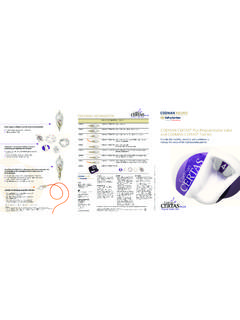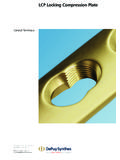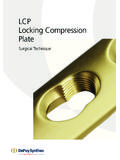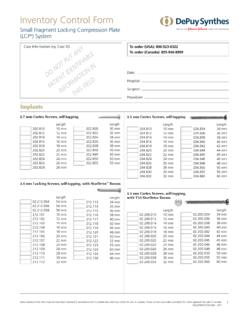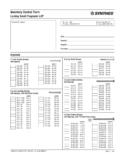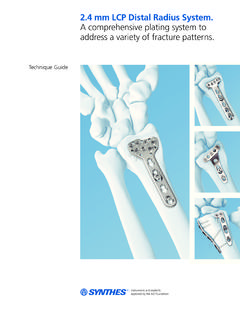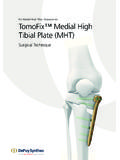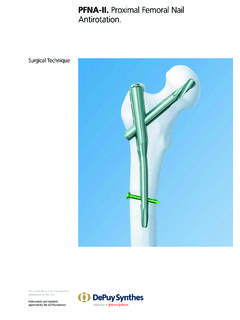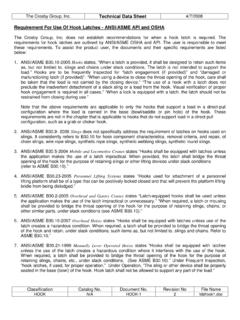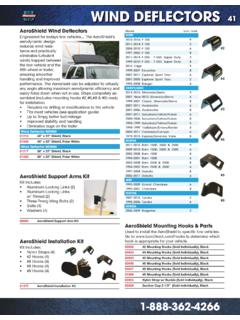Transcription of 3.5 mm LCP Hook Plate. Part of the Synthes locking ...
1 Mm LCP Hook plate . Part of the Synthes locking compression plate (LCP). system. Technique Guide Table of Contents Introduction mm LCP Hook plate 2. AO Principles 4. Indications 5. Clinical Cases 6. Surgical Technique Preparation 7. Position Patient 8. Approach 9. Reduce Fracture 10. Perform Osteotomy and Fix Temporarily 11. Predrill for hooks 13. Position mm LCP Hook plate 14. Insert Screws 15. Implant Removal (Optional) 20. Product Information Implants 21. Instruments 22. Product Information 26. Image intensi er control Synthes mm LCP Hook plate . Part of the Synthes locking compression plate (LCP) system. Low profile Precontoured Minimal hardware prominence Shaped to provide spring-effect, to aid in reduction hooks provide additional points of fixation Dual hook configuration facilitates placement locking screws provide a fixed-angle construct, which provides advantages in osteopenic bone where traditional Versatile screw purchase is compromised A single 3-hole plate can be used in multiple locations, applied to either the right or left side of the anatomy.
2 Resulting in less inventory required Scalloped undercuts Preservation of blood supply to the bone Sharp hooks Aid in placement of the plate 2 Synthes mm LCP Hook plate Technique Guide Olecranon Distal fibula / lateral malleolus Distal tibia / medial malleolus Nonlocking hole between the hooks Allows fracture compression with a lag screw ( home-run screw ) Hole zero Elongated nonlocking hole Designed for plate flexibility, and aids in placement and fracture compression Hole one Elongated Combi holes For controlled compression and optimal Hole two plate placement Rounded edges Hole three Minimize soft tissue irritation Synthes 3. AO Principles In 1958, the AO formulated four basic principles, which have become the guidelines for internal fixation1: Anatomic reduction Fracture reduction and fixation to restore anatomic relationships.
3 Stable fixation Stability by fixation or splintage, as the personality of the fracture and the injury require. Preservation of blood supply Preservation of the blood supply to soft tissue and bone by careful handling. Early, active mobilization Early and safe mobilization of the part and patient. 1. M ller, M. Allg wer, R. Schneider, and H. Willenegger, Manual of Internal Fixation, 3rd Edition. Berlin: Springer Verlag, 1991. 4 Synthes mm LCP Hook plate Technique Guide Indications The mm LCP Hook plate is indicated for fractures, osteotomies and nonunions of small bones, including the ulna, radius, tibia and fibula, particularly in osteopenic bone.
4 Synthes 5. Clinical Cases Case 1*. 78-year-old, gender unknown 21-B3 fracture: right arm Poor bone quality Preoperative lateral Postoperative AP Postoperative lateral Case 2*. 61-year-old male Open distal humerus fracture: right arm Good bone quality Olecranon osteotomy required to repair distal humerus Preoperative lateral Postoperative AP Postoperative lateral *Results from case studies are not predictive of results in other cases. Results in other cases may vary. 6 Synthes mm LCP Hook plate Technique Guide Preparation Required set / Small Fragment LCP Instrument and Implant Set, with mm Hex Drive Cortex Screws (stainless steel or titanium).
5 Note: The following technique is specific to the olecranon. Steps 1, 2 and 3 are specific to this surgical site, and should be modified when applied to other anatomy and fracture locations. Synthes 7. Position Patient 1. Position patient For an olecranon procedure, place the patient in lateral decubitus with the elbow flexed over a side rest. A small padded table can be placed under the forearm to support the elbow in extension if necessary. The supine position with forearm placed across the chest is also an acceptable position, especially with extended approaches to the lateral pillar or column. Note: For more information on fixation principles using conventional and locked plating techniques, please refer to the Small Fragment locking compression plate (LCP).
6 System Technique Guide. 8 Synthes mm LCP Hook plate Technique Guide Approach 2. Approach Make a posterior midline incision centered over the fracture or osteotomy site. The incision can also be slightly curved to the radial side to protect the ulnar nerve. Synthes 9. Reduce Fracture 3a Reduce fracture Instruments / mm Kirschner Wire, 150 mm, trocar point (stainless steel or titanium). or mm Kirschner Wire with Thread, 150 mm, trocar point, 5 mm thread length Reduce the fracture directly or indirectly depending on the type of fracture. Temporarily fix the fragment using Kirschner wires and / or forceps. Examine the reduction of the olecranon using image intensification.
7 Ensure Kirschner wires or forceps will not interfere with plate placement. 10 Synthes mm LCP Hook plate Technique Guide Perform Osteotomy and Fix Temporarily 3b Perform osteotomy and fix temporarily Perform an incomplete osteotomy of the dorsal cortex of the olecranon using a thin oscillating saw blade. Complete the osteotomy with a chisel in order to obtain an interdigitating fracture line. The fracture line should ideally run through the bare area of the sigmoid notch. The olecranon fragment is then placed to the lateral side. Protect the ulnar nerve on the medial side and the muscular branch to the anconeus on the lateral side. Perform surgery on the distal humerus as required.
8 Synthes 11. Perform Osteotomy and Fix Temporarily 3b. Perform osteotomy and fix temporarily continued Instrument mm Kirschner Wire, 150 mm, trocar points on both ends Insert a mm Kirschner wire with trocar points on both ends into the proximal olecranon fragment and reduce the osteotomy using an inside-out technique. Insert the wire into the fragment through the osteotomy from distal to proximal. The insertion point should be close to the articular surface and the wire should exit the fragment at the distal insertion line of the triceps tendon. Grasp wire from the tip exiting the proximal end of the olecranon. Retract wire proximally until its tip no longer protrudes from the osteotomy line.
9 Reduce the olecranon. Check for an anatomic reduction of the articular surface. Advance the previously placed wire from proximal to distal until it passes through the cortex of the coronoid process. Insert additional Kirschner wires if greater preliminary stability is required. Note: Take care not to drill in a radial direction, as the tip of the Kirschner wires and potential screws may interfere with forearm rotation. 12 Synthes mm LCP Hook plate Technique Guide Predrill for hooks 4. Predrill for hooks Instruments mm Drill Bit, quick coupling, 125 mm mm Universal Drill Guide Drill two holes for hook placement using the plate as a guide.
10 The holes should lie approximately 4 mm proximal to the insertion line of the triceps and centered over the olecranon. Note: The holes are drilled through longitudinal splits in the tendon fibers. Synthes 13. Position mm LCP Hook plate 5. Position mm LCP hook plate Optional instruments Bending Pliers for mm and mm plate , 150 mm length and Bending Pliers for mm and mm plate , 150 mm length or Bending Pliers for mm and mm Reconstruction Plates, 180 mm length, (two required). Place the plate on the olecranon, sinking the hooks into the predrilled holes. Be careful not to damage the surgical gloves or the patient's surrounding soft tissues with the sharp hooks .
